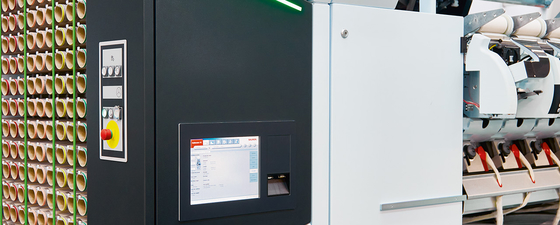The economic spinning of spinning mill waste has been a domain of the Autocoro for more than 40 years. In the past few decades, spinning mills still favoured the sole admixture of waste from the various process stages of the spinning mill, for example card waste and noils. Only 10 years ago, the Autocoro 8 opened the door to an economical spinning of sustainable fibres, processed from pre- and post-consumer waste. If you want to spin these fibres economically in increasing proportions of the mixture, up to 100%, there is still no way around the Autocoro from Saurer.
With the third generation, the Autocoro 10, yarn manufacturers can focus even more strongly on sustainable fibres. An example of this is the Intelligent Guidance System with large-format, highly visible and coloured LED signals above all spinning positions. The LED strips use colours to show the staff which task is pending at which spinning position, e.g. changing the sliver cans when the white LEDs light up. The LED signals save the operating personnel a lot of walking and increase the efficiency of the Autocoro without using additional electronic devices such as smartphones or tablets. As yarns made out of regenerated fibres tend to be coarser, this results result in short sliver can running times, and empty cans have to be exchanged for full cans more frequently. Customers producing this yarn spectrum particularly benefit from the new lighting concept.
The Autocoro 10 also includes other innovations that increase profits when processing regenerated fibres. These include a 25% higher package changing capacity and additional automatic machine cleaning with the Vacuum Trash Cleaner. Another feature are the new spinning components such as interchangeable fibre beard supports with different designs in the spin box. These control the cleaning of the fibres and thus get the maximum quality out of yarns made from regenerated fibres.


